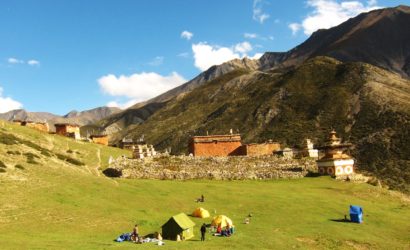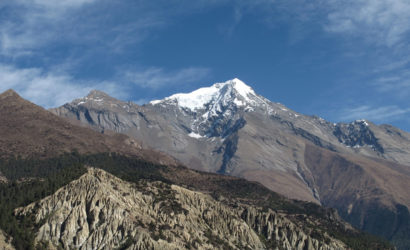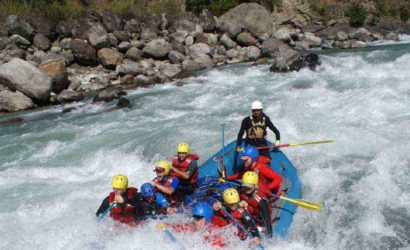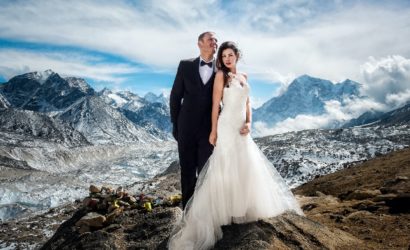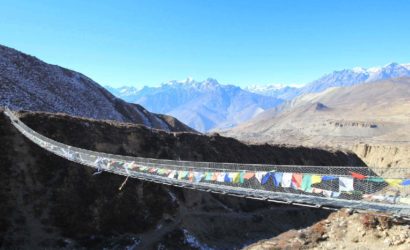Yala Peak, situated in the Langtang valley north of Kathmandu, stands at an elevation of 5530 meters, making it a sought-after trekking peak for those desiring higher altitudes than Tserko-RI (4770m) and Kyanjin RI (4895m).
This journey offers an exhilarating blend of trekking and climbing in the Langtang region, extending beyond conventional hiking.
Yala Peak ascent is relatively easy, requiring no prior climbing experience. However, participants should possess outfit experience and a reasonably good level of physical fitness and stamina.
The Yala Peak climbing adventure commences with a drive from Kathmandu to Syabrubesi. Along the way, you’ll traverse scenic locales such as Lama Hotel, Langtang Village, and Kyangjing Gompa.
The route is adorned with Gompas, Chortens, Mani Walls, and vibrant prayer flags, enhancing the allure of Yala Peak climbing. This expedition is well-suited for individuals with decent physical fitness and trekking experience.
Trek to Yala Peak Base Camp typically takes around 8 to 9 days, with opportunities to explore the surrounding natural beauty, including waterfalls, forests, and stunning mountain landscapes.
Once at the Yala Peak Base Camp, you will receive a brief training on climbing techniques, including the use of ropes, crampons, and ice axes. The climb to the summit typically takes around 1 to 2 days, depending on the weather and the pace of the climbers.
See more about Yala Peak Climbing in the blog below!
How hard is Yala Peak Climbing?
Yala Peak is considered a relatively easy peak to climb in the Himalayan region, and it’s often attempted by novice climbers who are looking for a beginner-level mountaineering experience.
The climb involves a moderate level of physical fitness, some basic mountaineering skills, and experience with using climbing equipment like ice axes and crampons. The peak doesn’t require technical climbing skills, but it does involve some steep sections that require careful footing.
Overall, Yala Peak is a great option for those who are looking to gain some mountaineering experience and want to attempt their first peak climb. However, it’s important to have a guide and to follow all necessary safety precautions to ensure a safe and successful climb.
Best Time To Go For Yala Peak Climbing
Spring:
Spring is considered one of the best times to embark on a Yala Peak climbing adventure for several reasons. During this time, the weather is stable and pleasant, making it favorable for climbing Yala Peak.
Spring brings moderate temperatures with clear skies. This allows climbers and trekkers to have clear and stunning views of the surrounding Himalayan peaks. The rhododendron forests come to life with vibrant blooms, adding a touch of natural beauty to the trek.
Moreover, the trails are less challenging due to the reduced snow cover, making the climb safer and more manageable, even for less experienced climbers.
Autumn:
Autumn, from September to November, is another ideal window for Yala Peak climbing. This season boasts crisp, dry weather, with clear skies and excellent visibility. The trails are in their best condition, making navigation easier, and the views of the snow-capped peaks are serene.
Autumn offers a post-monsoon serenity, allowing trekkers to enjoy the pristine landscapes in tranquility. The mild temperatures and relatively stable conditions make it the preferred choice for those seeking a comfortable ascent of Yala Peak.
This season’s charm lies in the breathtaking contrast between the azure skies and the snowy mountain vistas.
Off-Season Ascent to Yala Peak
Apart from the peak seasons like Spring and Autumn, Yala Peak also can be climbed during off-season. Usually, the monsoon and winter fall under this category. Though the expedition campaign can be launched during off-seasons, it is not recommended.
Expedition to Yala Peak during the monsoon (June to September) and winter (December to February) is not recommended due to natural hazards. Let’s explore why:
Monsoon Season (June to September):
During the monsoon, heavy rainfall drenches the Yala Peak region, causing several risks for mountaineers:
- Landslides: The rain makes the steep slopes unstable, increasing the chances of landslides. This can be very dangerous for climbers.
- Poor Visibility: The constant rain and thick clouds make it hard to see and navigate the terrain, leading to disorientation and accidents.
- Slippery Trails: The wet and muddy trails become slippery, making it difficult to trek safely. Climbing can be treacherous in these conditions.
Winter Season (December to February):
Winter in Yala Peak brings its own set of challenges that you should consider:
- Extreme Cold: The temperatures drop significantly, leading to frostbite and hypothermia risks for climbers who are not adequately prepared.
- Avalanches: The snow accumulation increases the risk of avalanches, which can be deadly in the mountainous terrain.
- Shorter Days: The days are shorter in winter, leaving less time for climbing, and it gets dark early, making it harder to navigate.
In both off-seasons, the hazards are severe, and there are limited rescue options due to the harsh conditions. Therefore, it’s advisable to plan your Yala Peak expedition during the spring or autumn seasons when the weather is more favorable, and the risks are significantly reduced. Safety should always be a top priority when venturing into the mountains, especially for younger or less experienced climbers.
What to consider while climbing Yala Peak
If you are planning to climb Yala Peak, there are several things you should consider to ensure your safety and success:
Physical fitness: Climbing Peak requires a good level of physical fitness. You should be in good shape and able to endure long hours of hiking and climbing.
Altitude sickness: Yala Peak is located at an altitude of 5,500 meters (18,044 feet), which can cause altitude sickness. It is important to acclimatize properly and stay hydrated to avoid this.
Climbing experience: Although Yala Peak is considered a relatively easy climb, it still requires some basic climbing experience. You should have some experience with snow and ice climbing, as well as knowledge of basic mountaineering techniques.
Equipment: You will need to bring appropriate equipment for climbing Yala Peak, including warm clothing, crampons, ice axes, and a helmet. It is also important to bring a first aid kit and other necessary safety gear.
Weather conditions: The weather in the Himalayas can be unpredictable, so it is important to keep an eye on the forecast and plan your climb accordingly. Avoid climbing during the monsoon season and be prepared for cold temperatures.
Guides and porters: It is recommended to hire a native Sherpa guide and porter for your climb, as they are experienced in the local terrain and can help you navigate safely. They can also carry some of your gear and make your climb more comfortable.
Permits: You will need to obtain a climbing permit from the Nepal Mountaineering Association before climbing Yala Peak. Make sure to obtain the necessary permits and follow the local regulations.
Required Permits & Their Cost
Trekkers embarking on the Yala Peak Climbing must ensure they have the necessary permits and logistics in place. Entry into the trekking region is contingent upon obtaining specific permits from the government, namely the Langtang National Park Entry Permit and the TIMS Card.
Most of our trek before climbing Yala Peak is inside Langtang National Park, a protected area in Rasuwa District dedicated to the preservation of Himalayan wildlife and plant species.
To access Langtang National Park, trekkers need to obtain the Langtang National Park Entry Permit, granting them entry into the protected land to appreciate the natural beauty and wildlife.
The Langtang National Park Entry Permit costs Nrs. 3000 per person, with South Asian (SAARC) country trekkers paying Nrs. 1000 per person, and Nepalese trekkers paying NRs. 100 per person.
In addition to the National Park Entry Permit, trekkers must also secure a TIMS (Trekkers’ Information Management System) card. There are two types: the Blue Card for group trekkers, priced at $10 per person, and the Pink Card for trekkers from SAARC nations, priced at $6 per person.
While there used to be a Green TIMS Card for solo trekkers, it is no longer applicable due to the government’s prohibition of solo trekking in Nepal.
Itinerary
Upon arrival in Kathmandu airport, you will be meet and greet by our airport representative from and transferred to your hotel. You can spend the rest of the day relaxing or exploring the city.
Today, we will make our way towards Syabrubesi, located in Rasuwa District in the north Nepal. It is a small village located on the edge of Langtang National Park.
To reach Syabrubesi, we must take a bus from Machhapokhari in Balaju. The drive takes around 6 to 7 hours to reach the spot. During the drive, we will pass through several villages such as Trishuli, Battar, Kalikastan, and Dhunche.
Upon reaching Syabrubesi, we will be accommodated at a guest house for overnight stay.
On the third day of our Yala Peak Climbing, we must begin our trek towards Langtang National Park. Starting from Syabrubesi, we will pass through the thick forests of pine and rhododendron.
The trek will be soothing as we will be walking alongside the Langtang River viewing the snow-covered peaks, including Langtang Lirung.
Upon reaching Lama Hotel, which takes around 5 hours to reach, we will stay overnight with a warm meal.
Today, we’ll depart the Lama Hotel in the morning, following breakfast, en route to Langtang Village. The uphill path through rhododendron and pine forests offers splendid views of Langtang Lirung.
After a few hours of trekking through the lower Langtang Region’s wooded terrain, we’ll reach Ghoda Tabela at 3030 meters. Here, amidst pasturelands, we’ll pause for lunch, observing livestock and Yaks grazing around.
From Ghoda Tabela, a steep uphill trail leads to Langtang Village at 3430 meters above sea level. Despite being severely affected by the 2015 earthquake, the village has undergone significant restoration efforts through international and governmental campaigns. We’ll spend the night at a tea house in Langtang Village.
On the fourth day of the Yala Peak Climbing, we’ll embark on a brief hike from Langtang Village to Kyanjin Gompa, an ancient Buddhist monastery showcasing the importance of Buddhism in the Langtang Region.
The trail passes through yak pastures and sparse settlements, offering challenging uphill sections with rewarding views of the Langtang range.
Upon reaching Kyanjin Gompa, the trek embraces Buddhist influences with prominent features like mani walls, chortens, and prayer flags. The site also houses religious scriptures and stone inscriptions, highlighting the rich Buddhist heritage.
There is also a German Cheese Factory, where you can purchase authentic Himalayan Yak Cheese.
High-altitude locations pose a risk of altitude sickness and related issues due to elevated air pressure and low oxygen levels, leading to breathing difficulties. Acclimatization is crucial at Kyanjin Village, achieved by gradual ascent, rest at lower altitudes, and prioritizing hydration, nutrition, and rest.
Kyanjin Village features centuries-old Kyanjin Gompa holding significant religious importance in the practice of Buddhism in the Langtang Region.
Additionally, consider a short hike to Kyanjin Ri at 4400 meters and Tesergo Ri at 4984 meters. The breathtaking views of Langtang Lirung, frozen lakes, and pristine glaciers make these destinations remarkable.
Now, we have reached near Yala Peak and the first thing we do is reach Yala Peak Base Camp. It takes around 5 to 6 hours to reach the spot.
The hike to the base camp is physically and technically demanding as the trail is rocky. Similarly, climbers must cross the uphill streams and also the technical trails covered with snow.
With strong preparation, climbers can easily reach Base Camp without issues. Upon reaching the base camp, we will set up a tent for staying overnight.
Today, we will conquer the Yala Peak by reaching to its top. The ascend starts early in the morning since it takes around 6 to 7 hours to reach the summit.
The climb is technical as it involves traversing snow and ice on very steep landscapes. After reaching the top, we will be welcomed with a breathtaking view of the snow-capped mountains.
The magnificent peaks of Shishapangma (8012m), Dorje Lakpa (6966m), Ganchenpo (6388m), Naya Kang (5844m), Langtang Lirung (7227m), and more will very stunning.
We will stay on the top for some minutes, snap the pictures, and then follow the trail to reach Kyanjin Gompa via Base Camp.
We will again use the same route and come back to Kyanjin Gompa and then go down through Lama Hotel. We shall sleep overnight in the same guest house.
On the tenth day of the Yala Peak Climbing, we will descend from Lama Hotel to Syabrubesi. The trek takes around 5 to 6 hours, where we will traverse the remote trail covered in dense forests.
Upon reaching Syabrubesi, we will rest overnight at a tea house.
Today, you will drive back to Kathmandu, where you can spend the rest of the day / evening exploring the city, shopping for souvenirs or simply relaxing. Overnight in Kathmandu.
Enjoy the delights of Kathmandu, taking a trip to a spa massage or listening to live music. Or simply relax in a quiet café. Also, it’s also spare day in case of bad weather or unforeseen reason.
In the evening, we will have a farewell lunch/dinner in a traditional Nepalese restaurant with cultural performances.
Our representatives will drop you off at the airport according to your flight schedule.


